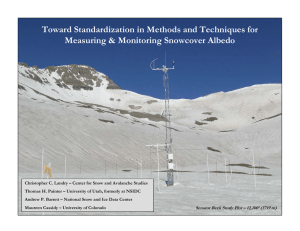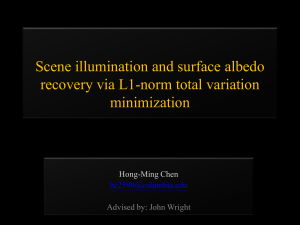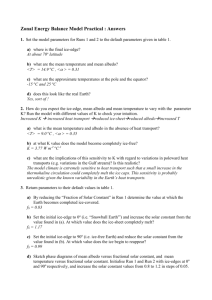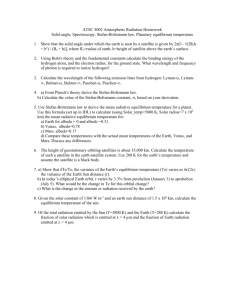Decadal variability in the Earth’s reflectance as observed by Earthshine Enric Pallé
advertisement
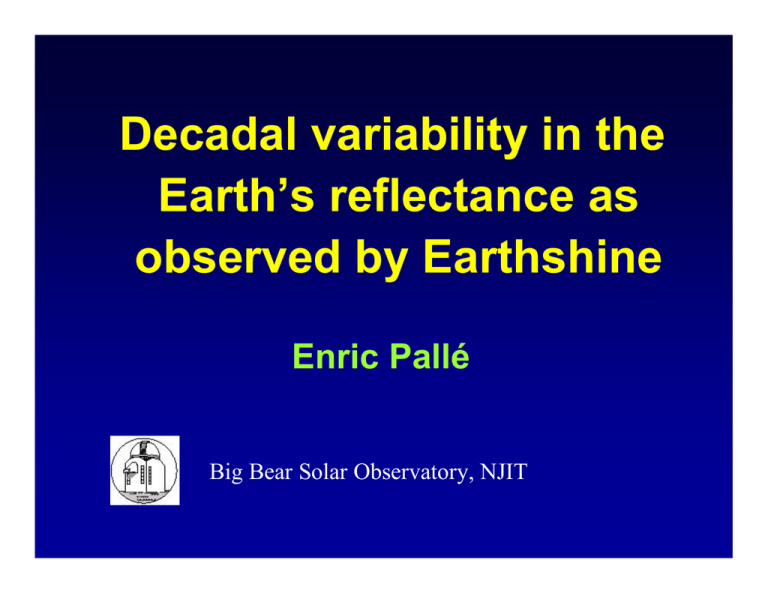
Decadal variability in the Earth’s reflectance as observed by Earthshine Enric Pallé Big Bear Solar Observatory, NJIT The albedo sets the input to the climate heat engine Pin = Cπ RE2 (1 − A); Pout = 4π RE2σ εT 4 ; T 4 = Solar constant Albedo C (1 − A); 4σε A ~ 0.30 The Solar Constant • We have measured the solar irradiance from space and we also have tried to ‘reconstruct’ it for past times. • Solar Irradiance changes can not explain the earth’s temperature variability without the help of stretching factors (amplification) Is the mechanism(s) indirect ? •EUV •Cosmic rays •Others? The climate is sensitive to A The average energy input from the sun is C(1-A)/4 = 240 W/m2 Changing A by 0.01 changes this by 3.4 W/m2 This is climatologically significant All anthropogenic greenhouse gases over last 150 years result in 2.4 W/m2 Doubling CO2 results in about twice this amount Linearization of the power balance (absent feedbacks) gives dT / dA ~ -1.5K / 0.01 The earth’s albedo is highly variable Clear Overcast Local albedo depends upon: Surface type Meteorology (clouds) Solar zenith angle (time of day) The global albedo varies with the seasons North/South land asymmetry Snow/ice cover Cloud patterns Land 0.16 0.50 Ocean 0.08 0.44 Desert 0.23 Snow 0.68 The Earthshine Project: Photometry goals The Moon enables us to monitor one aspect of climate change, the earth’s reflectance Observe earthshine to determine absolutely calibrated, large-scale, high-precision measurements of the earth’s reflectance Look for secular, seasonal and long-term variations in the albedo (like over a solar cycle) Transient phenomena like El Niño or volcanic eruptions Simulate the observational results Compare with observations Calibrate treatment of cloud cover Earthshine measurements of the Earth’s large-scale reflectance Waning / morning The Earthshine is the ghostly glow on the dark side of the Moon Origin of Earthshine first explained by Leonardo da Vinci First measured by Danjon beginning in 1927-34 and by Dubois 1940-60. ES/MS = albedo (+ geometry and moon properties) a b ⎛ I a Ta ⎞⎛ pb f b (θ ) ⎞⎛ Rem ⎞ ⎟⎟⎜⎜ ⎟⎟⎜⎜ ⎟⎟ pe f e (β ) = ⎜⎜ ⎝ I b Tb ⎠⎝ pa f a (θ 0 ) ⎠⎝ Re ⎠ θ=π−β Zero-airmass intensities Lunar reflectivities θ0 ~ 1o Rem ⎛ Res ⎞ ⎜⎜ ⎟⎟ ⎝ Rms ⎠ 2 Geometry π σ A = 2 = ∫ pe f e (β ) sin β dβ πRe −π β 3 pe f e ( β ) ; A* ≡ −2.5 log A* A ≡ 2 f L (β ) * Re dσ ≡ pe f e (β )Re2 dΩ f (0) ≡ 1 2 fL [ ] ( π − β )cos β + sin β (β ) = π A* → p* for historical reasons The Effective and Bond Albedos On any one night, we measure p*, the effective (or apparent) albedo (1 direction). (different Sun-Earth-Moon reflection angle) To obtain the Bond albedo, A, we integrate over all phases of the moon at monthly/yearly time scales 2 A = ∫ p * f L (θ ) sin(θ )dθ 3 Coverage during one night 15/10/99 Phase = -116 Evening In the sunlight & Visible from the Moon 04/09/99 Phase = +110 Morning Morning obs /Waning Moon Evening obs /Waxing Moon Modeling hourly variations Cloudy Asia North America Dark Arabian Sea Dark Atlantic Temporal offset due to cloud cover posting interval (12 hours) ?? Changes in the Earth’s albedo over the last 20 years Earthshine Observations: December 1998 – present ISCCP data June 1983 – September 2001 (to be updated) International Satellite Cloud Climatology Project (ISCCP) provides ~100 daily cloud variables on a (280 km)2 grid For each observation, calculate double-projected (E-S and E-M) area average of these variables Regress observed A* anomaly against the most significant of these This allows us to reconstruct the earth’s albedo as seen from BBSO since 1983 Multiple regression on p* Common period December 1998 – September 2001 Regress On: 9 9 9 cloud cover optical thickness surface reflectance Earth’s albedo 1983-2003 Albedo Effective Ground-level solar Irradiance And we are not alone: tropical satellite data OLR and SW The proxy implications Confidence in our results based on: 94-95 earthshine data agreement Positive/negative phases are similar Scrambling the data in mock reconstructions time/space support the trend Variation is large Albedo change is 6 W/m2 ; GHG up to now is 2.4 W/m2 Equivalent to 2% increase in solar irradiance, a factor 20!! the typical maxima to minima variations (0.3 W/m2) Reversibility suggests natural variations. GCM do not show such variations What is the climatic impact? Recent warming acceleration? Not so surprising… Although A does not only depend on mean cloud amount…. ….ISCCP data show reduction in cloud amount 1983-2001 Source: ISCCP web site The ES results are not inconsistent with satellite observations Radiation anomalies within ± 20o of the Equator B. Wielicki et al., Science p. 841, v. 295 (2002) Coverage of multiple stations •2nd Station now operating in Crimea; 3rd ready to go to Yunnan •Canary Islands optimal complement to BBSO •Prototype robotic telescope under construction for 8-station network Coverage with simultaneous observations Four station simulation Earthshine Spectroscopy Earth’s spectral albedo for 2004/11/19 Montañés Rodriguez et al. (in prep.) Rayleigh Scattering Chappuis Ozone band B-O2 A-O2 Atmospheric Water vapor Summary ES is a viable way to monitor the climate system on large scales and over long times By combining ES and ISCCP data, we have a 20-year record of the earth’s SW reflectance that Shows surprising interannual coherence and a large decadal variability that is likely natural (why??) Is not reproduced by current models Continued observations with a global network are warranted Visible and near-IR spectroscopic observations of ES are being analysed Are these changes due to GHGs? …. No Are these changes solar? …. humm!! Are they natural variability? ….. probably The End Some references Pallé E, Goode P.R., Montañes-Rodriguez P., Koonin S.E., Changes in Earth’s reflectance over the past two decades, Science, May 28th issue (2004). Qiu J., Goode PR, Pallé E, Yurchyshyn V, Hickey J, MontañesRodriguez P., Chug MC, Kolbe E, Brown CT, Koonin SE, Earthshine and the Earth’s albedo 1.: Precise and large-scale nightly measurements, Journal Geophysical Research, 108(D22), 4709, doi: 10.1029/2003JD003610 (2003). Pallé E, Goode PR, Qiu J, Yurchyshyn V, Hickey J, MontañesRodriguez P., Chu MC, Kolbe E, Brown CT, Koonin SE, Earthshine and the Earth’s albedo 2.: Observations and simulations over 3 years, Journal Geophysical Research, 108(D22), 4710, doi: 10.1029/2003JD003611 (2003). Goode PR, Qiu J, Yurchyshyn V, Hickey J, Chu MC, Kolbe E, Brown CT, Koonin SE, Geophysical Research Letters 28, 1671 (2001). MacDonald, GJ and Koonin, SE, Earthshine and Climate, The Observatory, 112, 59 (1992). http://www.bbso.njit.edu/~epb/ The global Earth is not too green 60% of Earth is covered by clouds at any time For 2003/11/19: 10:30 UT 13:00 UT Oceans 79% 71% Snow/ice 8% 11% Land 13% 18% Vegetation 9% 14% Unobstructed by clouds 5% 8% Regression against ISCCP 14 10-degree lunar phase bins ±(65-135) 310 nights 1999-mid 2001 r = 0.6; P << 0.001 Coefficients vary smoothly with lunar phase Cloud/Radiation changes this century ISCCP Solar Surface radiation (global dimming) Sunshine records Synoptic cloud observations Earthshine 1900 1950 2000 Comparison with photometric albedos and models for one night Montañés Rodriguez et al. (in preparation)

